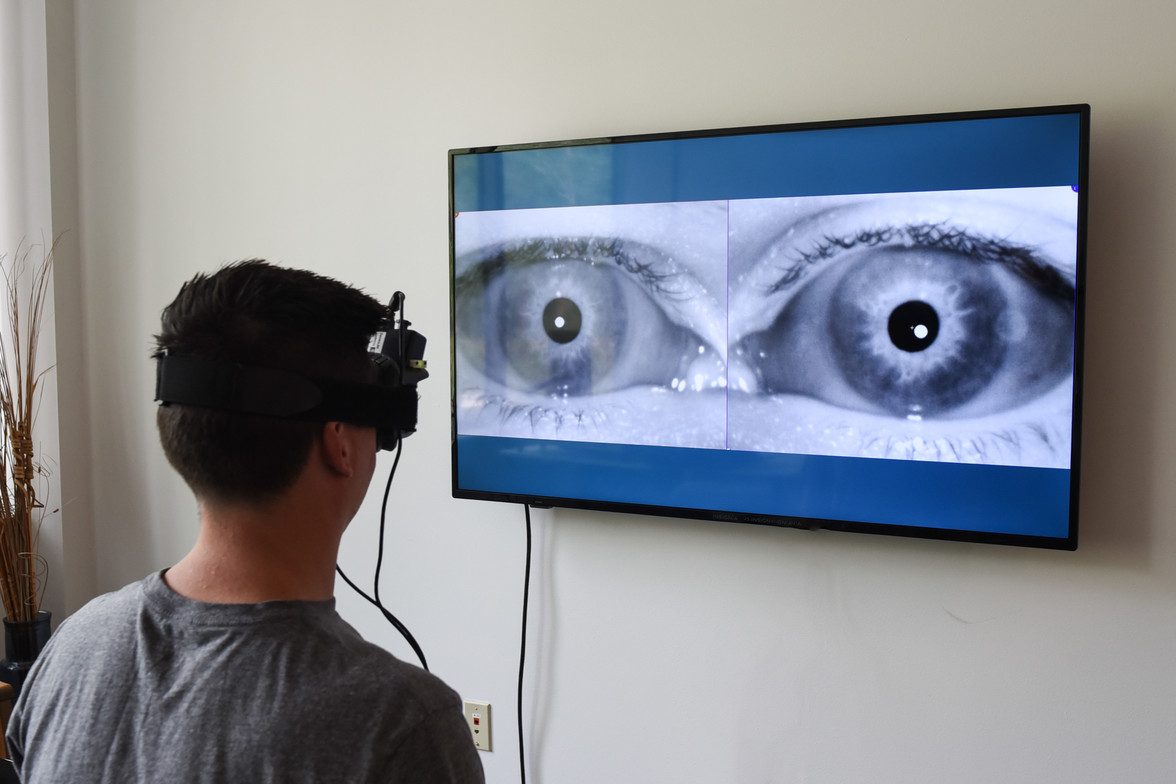If you’ve been living with unexplained dizziness, imbalance, or vision issues—especially after a concussion—you’re not alone. Dizziness is the third most common complaint in outpatient clinics, and it’s estimated that up to 50% of patients with mild traumatic brain injury (mTBI) experience vestibular symptoms like vertigo, lightheadedness, and poor balance.
But why do so many people struggle to get clear answers?
One reason: traditional imaging like MRI or CT often misses the subtle neurological disruptions that follow head trauma or inner ear dysfunction. That’s where videonystagmography (VNG) can make a difference.
What Is VNG?
VNG is a non-invasive test that uses infrared video goggles to record your eye movements. It allows us to analyze how your brain and inner ear process motion and maintain balance.
Your eye movements are a direct reflection of your central and peripheral vestibular systems. When something’s off—whether due to concussion, whiplash, or inner ear dysfunction—your eyes often reveal patterns that your body feels but can't explain.
At our clinic, we use VNG to uncover the hidden neurological factors behind persistent symptoms—especially in post-concussion patients who’ve been told “everything looks normal.”
What Does a VNG Test Include?
Here’s what we measure during a comprehensive VNG evaluation—and why each test matters:
Spontaneous Nystagmus
This checks for involuntary eye movements while you're sitting still.
Why it matters: Persistent nystagmus may signal an imbalance between the inner ear or brainstem vestibular systems. It’s often seen in vestibular neuritis, concussion, or central vestibular disorders.
Gaze Stability
You’re asked to stare at fixed targets in different positions.
Why it matters: Inability to hold steady gaze can suggest cerebellar dysfunction or ocular motor control issues—commonly affected by TBI.
A study in the Journal of Head Trauma Rehabilitation found that gaze instability affects nearly 60% of patients with chronic post-concussion syndrome.
Smooth Pursuits
You follow a slowly moving dot with your eyes.
Why it matters: Disruptions here often reflect dysfunction in cortical brain regions (frontal, parietal). People struggling with scrolling screens, reading, or following movement may have abnormal pursuit patterns.
Saccades
Quick eye jumps from one target to another.
Why it matters: Poor saccades are a hallmark of frontal lobe dysfunction, often seen in TBI, ADHD, and neurodegenerative conditions.
One study showed that abnormal saccades were present in over 70% of individuals post-concussion, especially those with visual tracking complaints.
Optokinetic Reflex (OPK)
Stripes move across the screen while your eyes reflexively follow them.
Why it matters: OPK evaluates integration between visual and vestibular input. Abnormal responses may indicate central processing dysfunction, especially in patients who feel overwhelmed by busy environments.
Why This Matters for Concussion and Chronic Dizziness
Symptoms like dizziness, fogginess, nausea, and visual instability can be debilitating—but they’re also often poorly understood or dismissed.
VNG allows us to:
-
Identify peripheral vs. central vestibular dysfunction
-
Pinpoint the brain regions involved
-
Customize your neurorehab plan based on objective data
-
Track progress over time
In cases of concussion, VNG becomes a critical tool in bridging the gap between what a patient feels and what traditional tests miss.
Dizziness Isn’t “Just in Your Head.” It Might Be in Your Eyes.
If you’ve been told “everything looks fine,” but you're still struggling with balance, motion sensitivity, or lightheadedness, VNG can help validate and explain what’s happening in your nervous system.
You don’t have to keep guessing—or suffering in silence.
Ready to Get Answers?
Our clinic uses advanced VNG testing to uncover the hidden causes of dizziness, vertigo, and post-concussion symptoms. We’re here to help you find clarity, direction, and relief.
Schedule your consultation today.
References:
-
Furman JM, Cass SP, Whitney SL. Vestibular Disorders: A Case-Study Approach. Oxford University Press, 2010.
-
Hoffer ME, Gottshall K, Moore R, Balough BJ, Wester D. Posttraumatic balance disorder. Otolaryngol Head Neck Surg. 2004;131(6):916-918.
-
Baloh RW, Honrubia V. Clinical Neurophysiology of the Vestibular System, 3rd Ed. Oxford University Press, 2001.
-
Heitger MH, et al. Oculomotor deficits in traumatic brain injury: evidence for widespread brain dysfunction. J Head Trauma Rehabil. 2009;24(6):377–385.
-
Samadani U, et al. Eye tracking detects disconjugate eye movements associated with structural TBI an






